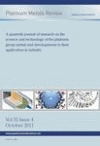-
oa Reactions of Oxygen with the Platinum Metals
III-The Oxidation of Palladium
- Source: Platinum Metals Review, Volume 9, Issue 4, Oct 1965, p. 126 - 129
-
- 01 Oct 1965
Abstract
In the third and concluding part of this survey of the changes that occur when the platinum metals are heated in oxygen at temperatures up to their melting point the behaviour of palladium is considered. The gain in weight when commercial palladium is heated to around 1000°C in air or oxygen, reported by many experimenters, is probably the result of the internal oxidation of base metal impurities. At higher temperatures, the primary cause of the loss of weight then observed is almost certainly the very high vapour pressure of palladium itself. The reaction between palladium vapour and oxygen to form PdO gas has yet to receive the experimental study it demands.
© Johnson Matthey


